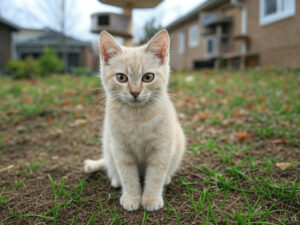Discover the Reasons Behind Your Cat's Bullying Experiences with Other Felines
Is Your Cat Enduring Bullying from Other Cats? Just like humans, cats rely on social interactions to nurture their emotional health. However, not all interactions foster positive relationships; some cats may engage in bullying behaviors as a means of asserting dominance over others, whether in the home or within the neighborhood. Understanding the intricacies of feline bullying is essential for helping your cherished cat regain their confidence and sense of safety in their environment.
Unlike playful roughhousing, which reflects affection, bullying in cats primarily presents itself through aggressive actions aimed at intimidation. This behavior extends beyond occasional swipes or hisses, developing into a persistent pattern of humiliating conduct. For example, one cat might consistently guard food bowls or obstruct pathways, instilling fear in other cats. Early recognition of these bullying behaviors is vital in safeguarding your pet's mental well-being and ensuring their overall happiness.
Taking immediate action against bullying behaviors is crucial to prevent further escalation into severe issues. A cat subjected to bullying may begin to shy away from specific areas, become less sociable, or even develop a reluctance to use the litter box due to anxiety. Spotting these warning signs promptly can protect your cat’s physical well-being and mental peace. The sooner you step in, the more effective your interventions will be in restoring balance and tranquility to your furry friend's living environment.

Recognizing the Warning Signs of Bullying in Your Cat
While cats lack the ability to verbally communicate their feelings, their behaviors and physical states can provide profound insights into their emotional well-being. If your feline friend is experiencing bullying, you may observe a spectrum of distress signals that indicate their discomfort and anxiety.
On a physical level, be vigilant for signs like scratches, bite marks, or uneven patches of fur, which could serve as quiet indicators of recent confrontations with a more assertive cat. Additionally, not every sign of distress is overtly visible; behavioral changes can also be significant. A once sociable cat might become withdrawn, frequently seek hiding spots, or exhibit sudden aggression previously unseen. Recognizing these shifts early is crucial for addressing bullying effectively.
Changes in eating habits and litter box usage can also offer vital clues about your cat's emotional state. Is your feline eating less or skipping litter box visits altogether? Such behaviors may stem from fear or stress, especially if a dominant cat is monopolizing these essential resources. Even within your home, if your furry companion appears skittish or hesitant, it could signify feelings of insecurity, as they may feel they are perpetually on high alert for bullying actions. Observing these changes closely is essential for early intervention against bullying.
Understanding Territory Intrusions: How Bullies Impact Your Cat's Safe Space
Your home should serve as a secure sanctuary for your cat, offering comfort and protection. However, if a bully cat invades your space, it can disrupt that sense of safety entirely. Some cats may audaciously enter your property, especially if there are accessible entry points. This intrusion can transform what should be a peaceful haven into a stress-laden environment for your resident feline.
If your cat seems anxious at home and you observe a neighboring cat lounging around your property, it may be time to delve deeper into the situation. Bullies often exploit open doors, unsecured windows, or cat flaps, seizing any opportunity to assert their dominance over your cat. Consequently, your kitty may start avoiding certain areas of the house or jump at sudden noises. These subtle behavioral changes can be significant indicators of heightened stress and anxiety levels.
Understanding the effects of these intrusions is crucial for maintaining your pet's emotional well-being. Once you identify the points of security breaches, you can take proactive measures to ensure your home remains a safe haven for your beloved furry family member. Establishing a secure environment is essential for restoring your cat's peace of mind and overall happiness.

Enhancing Your Home's Security: Creating a Protective Environment for Your Cat
Transforming your home into a protective fortress for your feline companion requires sealing off entry points that bully cats may exploit. One effective strategy is to install a cat flap with selective entry features. This innovation allows only your cat to enter and exit freely, significantly reducing the chances of unwanted visitors invading your home and asserting control over your pet.
Windows can also serve as potential entry points for intruders. Installing screens on windows that are frequently opened can prevent unwanted access while still allowing fresh air to circulate within your home. This way, you can maintain a comfortable indoor environment while safeguarding your cat’s territory from external threats.
Additionally, consider the placement of shared resources like food bowls and litter boxes. Dominant cats often try to control these essential areas by blocking access, making it essential to position resources in secure locations. By distributing resources throughout your home, you create obstacles for a bully cat, effectively establishing a protective barrier that ensures your cat's territory remains their own.
Designing Safe Outdoor Spaces for Your Cat's Exploration and Enjoyment
Outdoor adventures can be delightful for your cat, yet they may become stressful when bullies are nearby. Creating safe zones in your yard can significantly alleviate your cat’s anxiety about exploring the outdoors.
Consider adding cat platforms along fences or trees. These elevated spots give your cat an excellent vantage point and an escape route if a menacing cat appears. High ground can boost their confidence, allowing a timid kitty to feel more secure while observing their surroundings without fear.
If possible, provide access to a shed or garage, creating small shelters where your cat can feel secure. Even a simple outdoor cat house can offer refuge from more assertive cats trying to invade their territory. These structures play a vital role in helping your cat feel protected and relaxed during their outdoor excursions.
Furthermore, incorporate landscaping elements like potted plants or small bushes that serve as cozy hideaways. These natural barriers can provide comfort and concealment from unfriendly neighborhood cats, allowing your cat to enjoy their outdoor time without fear. By designing these little sanctuaries, you ensure your cat's outdoor experiences are both enjoyable and enriching.

Implementing Time-Sharing Strategies for Peaceful Coexistence in Multi-Cat Households
Living harmoniously with multiple cats doesn’t have to feel like a constant struggle. “Time sharing” is a fascinating concept where cats naturally stagger their outdoor activities to avoid conflicts. This instinctual strategy can serve as an effective peacekeeping method that fosters a more tranquil environment.
By understanding this instinct, you can encourage your cat to utilize specific areas during quieter times, thereby minimizing the chances of encountering bully cats. For instance, feeding your cat during off-peak hours can help reduce potential confrontations with more aggressive felines.
Observe local feline activity patterns and adjust your cat’s schedule accordingly, allowing them to enjoy their preferred spaces when the neighborhood is less busy. With slight routine adjustments, you can guide your cat to use the garden or yard during times when aggressive cats are likely resting, thus enhancing their sense of security.
Establishing a structured sharing of time allows each cat in the vicinity to enjoy their environment without undue stress. This approach not only fosters a sense of harmony but also alleviates the need for cats to feel they must fiercely compete for territory, making shared spaces more enjoyable for all involved.
Alleviating Outdoor Fear and Anxiety: Ensuring Secure Toileting for Your Cat
Fear can greatly affect your cat’s willingness to venture outdoors, even for essential activities like using the litter box. When a bully cat is nearby, your yard can quickly transform from a familiar territory into an intimidating environment, causing your feline to hold back or avoid their usual outdoor spots altogether.
Encourage gradual re-familiarization with these safe areas by accompanying your cat outside during calmer periods. This gentle approach helps them regain their confidence without the looming threat of a dominating cat shadowing their every move.
Consider establishing alternative toileting areas situated away from high-traffic zones that are less likely to attract troublesome cats. If outdoor stress levels are too high for comfort, temporary indoor solutions may also ease the transition and ensure your cat's needs are met effectively.
Reducing intimidation factors is essential, which may require you to observe and narrate the local feline dynamics like a dedicated detective. By identifying the bully’s patterns and alerting your cat, you can help them gradually reclaim their territory without unnecessary confrontations. Supporting your feline friend in regaining their footing and old routines can transform your garden from a battleground into an enchanting paradise, allowing them to scratch, climb, and explore freely once again.
The Article : Is My Cat The Victim Of Bullying Appeared First On Unity Pets.
The Article Is Your Cat a Victim of Bullying? Here’s How to Tell Was Found On https://limitsofstrategy.com





No responses yet